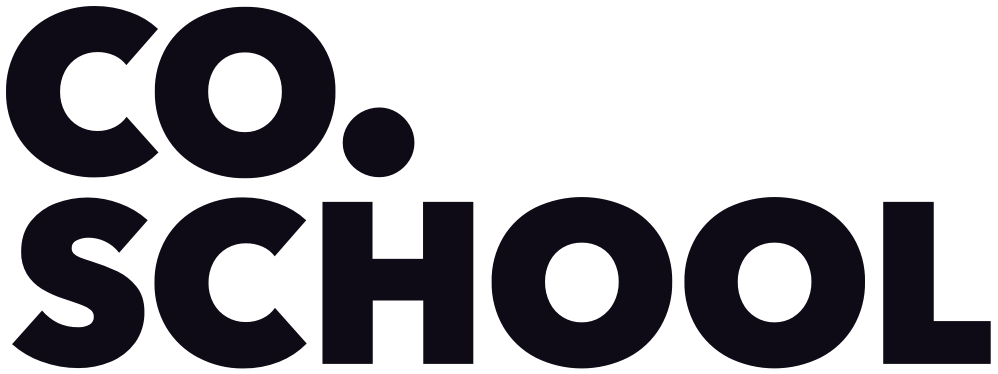Facilitator's Library
Co.school's Offerings
Explore the toolkit:
Creativity & Human Centered Design
Facilitation & Hosting
Online Facilitation Guide
by Co.school
Authentic Facilitation
by Co.school
The Art of Gathering
by Priya Parker
by Co.school
Authentic Facilitation
by Co.school
The Art of Gathering
by Priya Parker
Rituals for Virtual Meetings
by Fajardo Ozenc
by Fajardo Ozenc
Sprints & Workshops
Workshop Exercises
These sites are a goldmine for finding specific agendas and activities.
Gamestorming
Gamestorming
Exercises to Spark Creativity in Ideation
by InnovationLab
by InnovationLab
Web Tools
Powerful, understated tools are a facilitator's secret weapon.
Session Lab: For collaborating designing and planning agendas (also includes resource library)
Session Lab: For collaborating designing and planning agendas (also includes resource library)
Howspace: For AI-powered, asynchronous group contributions
Equity & Ethics Considerations
Design Ethics Reading List
Liberatory Design: a set of tools and resources to integrate the practice of design thinking with a mission toward equity
Liberatory Design: a set of tools and resources to integrate the practice of design thinking with a mission toward equity
Questions & Possibilities
(Questions submitted by readers and workshop participants.)
Sometimes I struggle to jump on to finding the solution without giving enough time to find that middle ground. What suggestions do you have?
It is a classic problem! In fact, it's a product of our education, socialization and training in most Western institutions. We are incentivized, rewarded, and affirmed for our abilities to solve problems quickly. Don't underestimate the challenge in going against so much conditioning!
In what ways are you as a person practicing your ability to slow down? Do you have a mindfulness practice: reading, reflecting, journalling, walking, yoga, mindfulness meditation?
In facilitated sessions, are you ensuring you are leaving enough time on the agenda to truly stay in "divergent" thinking? Use time and design as your guide to stay true to your intention.
In what areas have you observed the benefits of "finding the middle ground"? When it goes well, what has it helped you achieve? Can you consolidate that to a simply purpose or values statement, and post that somewhere prominent?
In what ways are you as a person practicing your ability to slow down? Do you have a mindfulness practice: reading, reflecting, journalling, walking, yoga, mindfulness meditation?
In facilitated sessions, are you ensuring you are leaving enough time on the agenda to truly stay in "divergent" thinking? Use time and design as your guide to stay true to your intention.
In what areas have you observed the benefits of "finding the middle ground"? When it goes well, what has it helped you achieve? Can you consolidate that to a simply purpose or values statement, and post that somewhere prominent?
What are some tips or frameworks that can be used to frame the problem?
- The "When Co-Creation Fits" grid asks some healthy questions to help you determine the nature of your problem
- The "How Might We" formula gives you three questions to ask
1. Who is the community I am serving?
2. What is the future state we hope for?
3. What are my design constraints?
The "Reframe" tool from THNK is a healthy way to get underneath a problem, and one's limiting beliefs.
How do you navigate stakeholder and user feedback in the solutions phase while still making decisions quickly and having the individual with the most context remain the decision maker?
Establish your decision-making criteria: Consider conducting a workshop in order to establish your decision-making criteria. Having clear, shared purposes will help you all feel like you can fairly and equitably make decisions, based on a shared understanding of what constitutes a "good decision."
Be clear about the roles: In the Google Sprint format, one specific person is given the role of Decider. They are equipped to make decisions during stalemates or ties. By making it clear that they are indeed the owner of the decision, it helps things move more quickly.
Don't undercut the value of the humans offering feedback: The involvement of others, and the relationships you are building, are also part of the culture you are creating.
Only ask for input when you intend to use it: If you don't intend to use stakeholder input, don't ask for it. Right-size your approach, and only using co-creative methods if it matches your needs.
Be clear about the roles: In the Google Sprint format, one specific person is given the role of Decider. They are equipped to make decisions during stalemates or ties. By making it clear that they are indeed the owner of the decision, it helps things move more quickly.
Don't undercut the value of the humans offering feedback: The involvement of others, and the relationships you are building, are also part of the culture you are creating.
Only ask for input when you intend to use it: If you don't intend to use stakeholder input, don't ask for it. Right-size your approach, and only using co-creative methods if it matches your needs.
In synthesis: I'd love to explore or learn some models or best practices when team members come to drastically different summaries from the same data set and how to move forward.
- Host a dialogue session to hear from both team members: By listening well to each contribution, it's a chance to understand the value in both approaches. Is this a chance to see things from an alternate point of view?
- Consider "branching" the design thinking flow from that point: Treat it like a chance for an A/B test, or prototype. Commission one team to pursue the first interpretation, and another to pursue the second.
- Return to the purpose, of both your organization's mission and your team's work: What are you trying to achieve? How might we navigate this stalemate with at purpose in mind?
What processes can facilitate meaningful stakeholder input and engagement while keeping their lift light?
- Listen well to understand their aims.
- Connect your work with their purpose.
- See about offering compensation (gift cards are great).
- Remember that involvement often RESULTS in real buy-in and commitment.
- Be clear on what the ask is; be respectful of their time.
What are the tools (besides the double diamond) of co.creation and how can we practice them for specific situations we've surfaced?
I've loved the Hyper Island toolkit as a starting point. It helps you locate specific agenda and activity designs that solve specific problems.
In general, this is the work of facilitating, and developing your style over the years ahead: gaining familiarity with what tools work best, which ones you like, adapting them to suit your moment. There are so many amazing tools for each part of the double-diamond — the toolkit above can be a jumpstart for your exploration.
In general, this is the work of facilitating, and developing your style over the years ahead: gaining familiarity with what tools work best, which ones you like, adapting them to suit your moment. There are so many amazing tools for each part of the double-diamond — the toolkit above can be a jumpstart for your exploration.
How do you make sure that a few voices don't overpower the process of design thinking?
Remember, your whole reason for choosing a design thinking process is to WIDEN input, gather perspectives from the margins, hear from the many and not just the few — you could say this question is your whole job as a facilitator and process designer!
In live sessions, always ensure there is room for all people to process information at the speed that works for them. If possible, provide reading materials in advance. Allow folks time to reflect, think, process and share.
Throughout a process, make it known who actually has the decision making authority — be honest about whether that is democratically shared, or if it sits with one person.
You might find this webinar useful, all about Practicing Inclusive Engagement.
In live sessions, always ensure there is room for all people to process information at the speed that works for them. If possible, provide reading materials in advance. Allow folks time to reflect, think, process and share.
Throughout a process, make it known who actually has the decision making authority — be honest about whether that is democratically shared, or if it sits with one person.
You might find this webinar useful, all about Practicing Inclusive Engagement.
How can you develop design thinking and analytical solve problem skills in our team members when you are dealing with pragmatic people?
In a sense, all these tools are extremely pragmatic. What's the easiest way to achieve group consensus? Develop innovative ideas? Break through a disagreement? Facilitation is an extremely pragmatic skillset, and saves countless of hours, days, weeks, months otherwise wasted solving the wrong problem. Invite them to see the pragmatic value that design thinking brings.
Plus, pragmatic people are beautiful. They help us stay grounded and anchored, they help us implement, and they help us think realistically. That type of thinking is welcome and necessary! Especially at the right spot. Try exploring Edward De Bono's "Six Thinking Hats" — it's a way of helping name the type of input you're looking for. Pragmatic people tend to see the dangers/risks (the "black hat") or the information/facts (the "white hat"). At what part of the process would it be good to get some black hat or white hat perspectives? Knowing the answer to that can help you involve them at the right time.
We need many, many diverse ways if thinking of we are going to navigate the future well. We need not diminish the value of one way of thinking over another. We need to welcome pragmatic and creative folks into harmonious partnership, to get the best of our paradoxical ways of seeing the world.
How do you best encourage participation and engagement in virtual sessions?
- Give people time to reflect: At least three minutes to think through a question is helpful.
- Allow people alternatives to public speaking: A tool that allows text input is helpful.
- Set the tone in advance: A welcome email or video can go a long way.
- Anchor the meeting with a clear intention: Invite people to engage — better yet, have them co-create a social charter
- Try music: Reflective music can sometimes allow the space for productive quietness. It allows people to think, purposefully, instead of sitting in awkward zoom silence.
- 1-2-4-all: From Liberating Structures, this methods invites you to move from individual reflection, to pairs sharing, to small group sharing, before asking somebody to share in front of the whole group.
- Don't exceed 3 hours
- Don't have any one presenter talking for more than 15 minutes straight
- Design a session that is driven by user participation! Less content, more questions.
How to narrow down which strategy to use for storyfinding/listening? (i.e. interviews, circle practice, world cafe)
Lovely question.
Size of group or community is a helpful filter: A community-organization with under 100 people might do well with something like World Cafe. A larger community, like a city, you'd probably want a survey. A smaller group, 50 or less, you could do circle practice with.
Group objective is another helpful filter: what are you trying to achieve?
Kate Sutherland's book "We Can Do This!" as well as adrienne maree brown's "Holding Change" offer some helpful frameworks for determining what your group needs.
We're here to help!
Learning facilitation is a lifelong learning journey. I'd love to help you any time you need a hand. Drop me a note anytime at kevan@co.school and we can set up a time to chat through any collaboration and co-creation challenges you might be facing.
Kevan Gilbert
Co.school founder and lead facilitator


